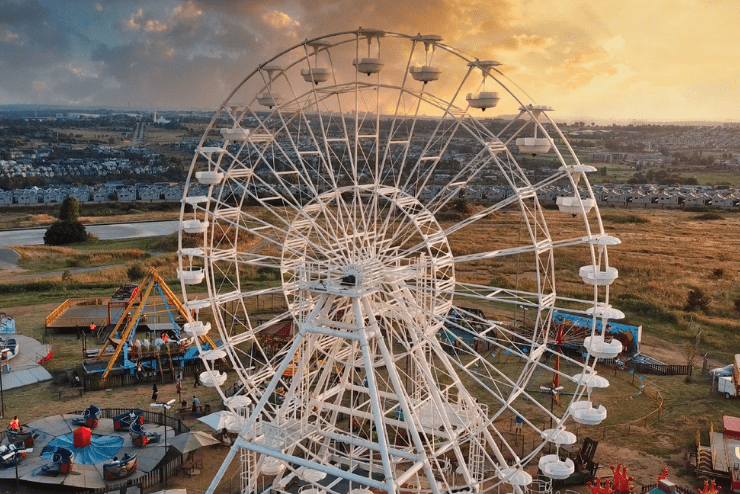The Of Johannesburg North Attractions
The Of Johannesburg North Attractions
Blog Article
Johannesburg North Attractions - The Facts
Table of ContentsUnknown Facts About Johannesburg North AttractionsJohannesburg North Attractions Can Be Fun For AnyoneThe Only Guide for Johannesburg North AttractionsNot known Details About Johannesburg North Attractions Johannesburg North Attractions Things To Know Before You BuyUnknown Facts About Johannesburg North Attractions
The city owes its place to the visibility of a much more precious resource: gold. The city expanded on the edge of the Witwatersrand Main Reef, a below ground stratum of gold-bearing quartz-silica empire that arcs for hundreds of miles below the Highveld. Most of the gold mines in the city ceased operation in the 1970s, yet in its day the Witwatersrand gold sector made up more than 40 percent of the globe's yearly gold manufacturing.Johannesburg has a warm environment. Summer season temperature levels balance concerning 75 F (24 C); winter temperatures balance concerning 55 F (13 C) and just sometimes dip listed below freezing. The city takes pleasure in regarding 8 hours of sunshine per day in both winter season and summer. Rain averages concerning 28 inches (700 millimetres) per annum, but the total varies considerably from year to year.
What rainfall the city obtains falls almost exclusively in the summertime, frequently in stunning late-afternoon electric storms. Air pollution postures a considerable issue, especially in the wintertime months, when thermal inversions impede the westward flow of air from the Indian Sea. Pollution is most severe in the densely settled Black municipalities on the city's perimeter, where numerous homeowners still depend on coal for gas.

How Johannesburg North Attractions can Save You Time, Stress, and Money.
The balance of the city is occupied by whites. Accommodation differs in character and quality.
Physical growth, although somewhat limited by transport, proceeded rapidly as migration to South Africa, and Johannesburg in specific, boosted drastically.
The majority of poor residential areas were combined, with bad blacks and whites living together, although the well-off residential areas were usually reserved for whites.
The estimated populace of the area is 200,000, [] but the number of individuals living in the central city on a casual basis is unknown, as lots of are prohibited immigrants. Most higher-income locals and white individuals have transferred to the northern residential areas and have been changed by lower-income black individuals. The unemployment, education and learning, and age profiles of the area are all unknown, as a result of the difficulty of acquiring trustworthy details concerning the area.
The Greatest Guide To Johannesburg North Attractions
Centred on the CBD, the region includes the suburban areas of Yeoville, Bellevue, Troyeville, Jeppestown, and Berea to the eastern. To the west it infects Pageview (Johannesburg North attractions) and Fordsburg. There are little commercial areas to the south, such as City West-Denver and Benrose. Around 800,000 commuters travel through the central city each day, and it operates as a local shopping node for visitors from the southerly suburbs. Yeoville and Bellevue have a mix of apartment and solitary residential systems on little whole lots. The region is located on a hilly divide that runs from eastern to west. One of the most obvious geographical function is Observatory Ridge, which is called for the huge observatory located on it. The entertainment areas are no more utilized, because of safety problems.

Johannesburg Stadium, a training school for both the Golden Lions and Orlando Pirates, is adjacent. The eastern suburban areas of Johannesburg are link located in the city's 7th [] and 9th [] areas. The area is also functionally incorporated with East Rand border communities outside of like this the official limit of Johannesburg, such as Bedfordview and Edenvale (both part of Ekurhuleni Metropolitan Community).
Fascination About Johannesburg North Attractions
R. Tambo International Flight Terminal). The eastern suburbs are a few of the oldest areas of Johannesburg, there are huge neighborhoods of Jewish and various other European backgrounds, the bulk of the populace is English speaking. There are three golf training courses as well as a number of secured ridges with viewsites. There are a number of strong and up-market home entertainment and purchasing locations in the east such as the Eastgate Shopping Center and the Greenstone shopping center.
The location is mostly made up of old "matchbox" houses, or four-room homes constructed by the government, that were built to offer cheap accommodation for black workers throughout apartheid. Soweto is an abbreviation, representing "South Western Townships". Road after road in this location is lined with matchboxes; nevertheless, there are a few smaller areas where prosperous Sowetans have actually constructed residences that are a lot more comparable in stature with those in more affluent suburbs.
Hostels are one more prominent physical feature of Soweto. Initially constructed to house male migrant employees, numerous have been improved as dwellings for pairs and family members. The N1 Western Bypass skirts the eastern limit of Soweto. The suburban area was not historically enabled to create work centres within the location, so mostly all of its homeowners are commuters to various other components of the city.
The 20-Second Trick For Johannesburg North Attractions
The property locations in the north residential areas are mainly formal, with no significant locations of informal real estate, or housing that lacks a permanent structure. This is a well-known location, there is a pattern of land use content change from residential to industrial, especially along major arterial roads and around established nodes.
The location is well attached to roadway networks, specifically along the north-south axis developed by the M1 and N1. Roads to the eastern and west are much less well created, as there are no highways taking a trip in that instructions. Towards the northern border of the city, the density of growth decreases, leaving large locations of primitive land around Midrand.
The smart Trick of Johannesburg North Attractions That Nobody is Talking About
The initial suburban area to the north of the central city is Parktown, which lies on a hillside forgeting the inner city and Hillbrow. It has many well-off locals and Edwardian-design mansions, in addition to the Education and Medical universities of the University of the Witwatersrand. The huge concrete Charlotte Maxeke Johannesburg Academic Healthcare Facility controls the horizon of Parktown.
Report this page